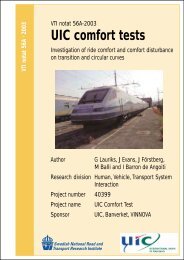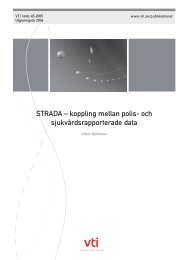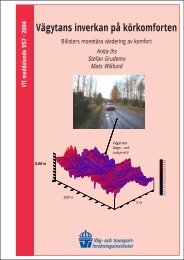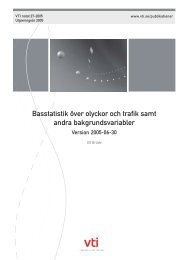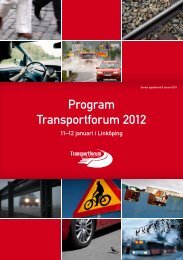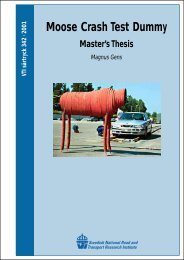Vehicle control and drowsiness - VTI
Vehicle control and drowsiness - VTI
Vehicle control and drowsiness - VTI
- No tags were found...
Create successful ePaper yourself
Turn your PDF publications into a flip-book with our unique Google optimized e-Paper software.
4.3 Steering wheel movements <strong>and</strong> steering wheelvariabilityAs reported by Wylie et al. [32], steering wheel variability is related to the amountof <strong>drowsiness</strong> in drivers (variability greater as drivers become more drowsy) afterbeing adjusted for road dependent effects. Steering wheel variability is alsostrongly <strong>and</strong> reliably affected by location on the route. Therefore this measuremust be corrected for route dependent effects if it is to achieve its full potential asan indicator of driver fatigue. The adjustment for route dependent effects can beperformed for example by subtracting the all-driver average steering wheelvariability associated with each mile of road, thus reducing the variationassociated with road curvature. The authors of the article also suggest consideringthe power spectral density of the steering wheel angle in relation to fatigue.Clearly this approach is arduous for real-time measurements.Mitsubishi has reported the use of steering wheel sensors <strong>and</strong> measures ofvehicle behaviour (such as lateral position of the car) to detect driver <strong>drowsiness</strong>in their “advanced safety vehicle” [33]. Toyota uses steering wheel sensors(steering wheel variability) <strong>and</strong> pulse sensor [34] (to record the heart rate <strong>and</strong> theheart rate variability of the driver) to achieve the same goal, though no detailsabout the exact nature of the measures used are available. The following imagerepresents a <strong>drowsiness</strong> detection example from the Toyota study.Figure 2 Drowsiness judgment example from [34]. “General judgment (actuation)”is the system output (detection of <strong>drowsiness</strong>), “self declaration” is thedriver’s subjective <strong>drowsiness</strong> experience, the “fluctuation” (pulse of the driver)<strong>and</strong> the “steering adjustments interval“ are the recorded input variables for the<strong>drowsiness</strong> detection. Note: the authors do not explain how the three thresholdsare set.20 <strong>VTI</strong> meddel<strong>and</strong>e 922A



